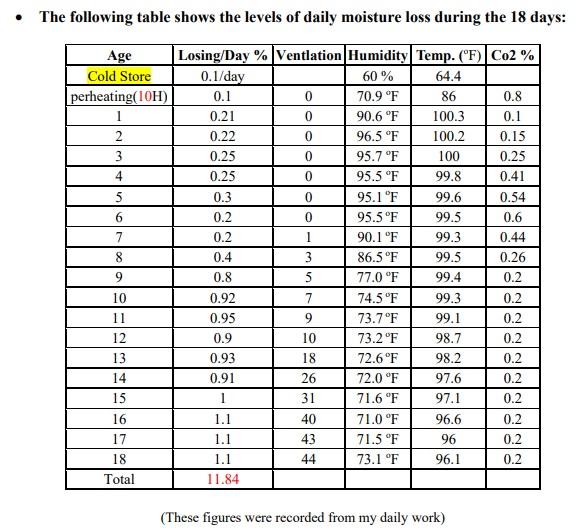The Impact of Humidity and Egg Size on Incubation Performance
Published: July 10, 2023
By: Ahmed Samer / Hatchery Manager @Etihad, Incubation Specialist
Introduction
When it comes to incubating eggs, one of the most crucial factors to consider is humidity. Proper humidity levels during incubation can greatly impact hatchability, embryonic development, and chick quality. In this article, we will explore the relationship between humidity and egg size and how they affect the incubation process. We will delve into the scientific research and provide practical advice for achieving optimal results.
The Role of Humidity in Incubation
Humidity plays a vital role in egg incubation. It affects the water balance of the egg, which is crucial for the formation of the air sac and embryonic respiration. The desired humidity level allows for efficient inflation of the respiratory air sacs of the hatchling. Insufficient humidity can lead to smaller air cells, suffocation of the embryo, and tough membranes that are difficult to break. On the other hand, excess humidity can result in smaller air cells, drowning of the chick, and the inability to breathe during hatching.
Monitoring Humidity with Air Cell Size
One practical way to monitor humidity levels during incubation is by observing the size of the air cell. As eggs lose water during incubation, the air cell gradually expands. By tracking the progression of the air cell, you can gauge whether humidity levels are appropriate. The ideal air cell size should occupy about one-third of the egg at transfer, with the lower tip reaching the middle of the egg. A small air cell indicates high humidity, while a large air cell suggests low humidity.
Optimal Egg Weight Loss
Egg weight loss is another important indicator of humidity levels during incubation. It is recommended that eggs lose around 13% of their weight for older flocks and 11% for younger flocks. This weight loss is achieved through water evaporation from the albumen and internal liquids. Proper weight loss ensures the right balance between water and air within the egg, allowing for healthy embryonic development.
The Influence of Egg Size on Incubation
Apart from humidity, egg size also plays a significant role in incubation performance. The size of the eggs can affect hatchability, embryonic mortality, and chick quality. Studies have shown that eggs within an intermediate weight range tend to have better hatchability than small or large eggs. Moreover, different egg sizes can influence the proportion of internal components, such as the yolk. Eggs with a higher yolk component may affect embryonic growth and development.
Effect on Embryonic Mortality and Chick Weight
The size of the eggs has been found to impact embryonic mortality rates. Medium-sized eggs often have lower mortality rates compared to small or large eggs. This could be attributed to the balance between the size of the embryo and the available nutrients within the egg. Additionally, egg size has an effect on chick weight. Larger eggs tend to produce heavier chicks, while smaller eggs may result in lighter chicks.
Research Findings on Humidity and Egg Size
Several research studies have been conducted to investigate the relationship between humidity, egg size, and incubation performance. These studies provide valuable insights into the optimal conditions for successful incubation.
In a recent study by Bassareh and Rezaeipour, the impact of humidity and egg size on hatchability, embryonic development, and chick yield in a broiler breeder flock was examined. The study utilized different levels of wet bulb humidity and various egg sizes. The results showed that humidity levels of 82.5°F had a positive effect on total and fertile hatchability, while humidity levels of 83°F increased the weight of one-day-old chicks. Medium-sized eggs demonstrated better hatchability, fertility, and chick yield compared to small or large eggs. These findings suggest that a humidity level of 82.5°F and medium-sized eggs can enhance incubation performance.
Another study by Van der Pol et al. focused on the effect of humidity during incubation on embryonic mortality and chick quality. The research found that low humidity during incubation led to increased egg weight loss, third week embryonic mortality, and decreased hatch of fertile eggs. However, the study also revealed that humidity levels did not significantly affect hatch duration or chick quality characteristics. This indicates that while humidity affects hatchability, it has little impact on chick quality or performance during the initial post-hatch period.

Practical Recommendations for Incubation Success
Based on the research findings, as well as practical experience, there are several recommendations to optimize incubation success:
1. Monitor air cell size: Regularly check the size of the air cells during incubation to assess humidity levels. The air cell should gradually expand, occupying about one-third of the egg at transfer.
2. Maintain optimal egg weight loss: Aim for the recommended weight loss of 13% for older flocks and 11% for younger flocks. This can be achieved through proper humidity control.
3. Consider the impact of egg size: Take into account the size of the eggs and its potential effects on hatchability, embryonic mortality, and chick weight. Medium-sized eggs often yield better results in terms of hatchability and overall chick performance.
4. Adjust humidity levels accordingly: Based on the research findings, a humidity level of around 50-55% is generally recommended. However, it is important to consider factors such as eggshell quality and adjust humidity levels accordingly.
5. Use a step-down humidity program: Consider implementing a step-down humidity program to create a more uniform environment in the incubator. This program involves gradually reducing humidity levels towards the end of incubation.
6. Avoid extreme humidity levels: Ensure that humidity levels do not fall below 45% or exceed 60% to prevent dehydration or excessive moisture in the eggs.
7. Monitor embryo development: Regularly candle the eggs to assess the growth and development of the embryos. This can help identify any potential issues and make necessary adjustments to humidity levels.
8. Seek professional guidance: If you are unsure about the optimal humidity levels for your specific breed or environment, consult with experts in the field or experienced breeders for guidance tailored to your situation.
By following these recommendations and closely monitoring humidity levels and egg size, you can increase the chances of successful incubation and hatchability.
Conclusion
Humidity and egg size are significant factors in incubation performance. Proper humidity levels ensure the development of a healthy air cell and allow for optimal embryonic growth and hatching.
Medium-sized eggs tend to have better hatchability and lower embryonic mortality rates. By understanding the relationship between humidity, egg size, and incubation outcomes, breeders can make informed decisions and implement appropriate measures to achieve successful incubation.
Remember to regularly monitor air cell size, maintain optimal egg weight loss, and adjust humidity levels accordingly. By doing so, you can create an ideal environment for the development of strong and healthy chicks.
Related topics:
Authors:
Recommend
Comment
Share

Would you like to discuss another topic? Create a new post to engage with experts in the community.






